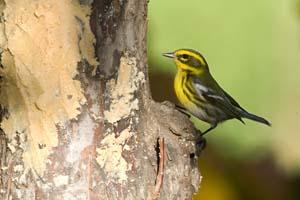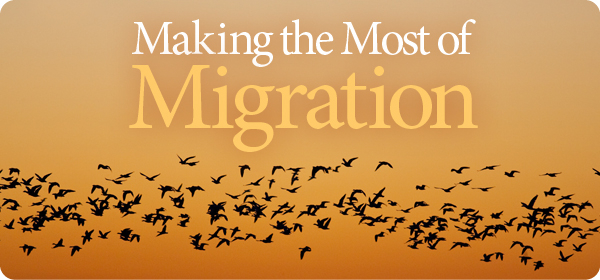 Set a Place for Your Globe-trotting Guests
Set a Place for Your Globe-trotting Guests
More than 300 bird species found in North America during the summer make their way to Central and South America or the Caribbean, some covering distances of nearly 7,000 miles. Parks, backyards and nature refuges across the country will host these winged visitors as the birds make their way to their winter homes.
Migration is a fascinating part of bird behavior. Besides the amount of daylight, it appears that age, sex, weather and the availability of food, water and shelter are the major factors in migratory behavior.
While migration is still not completely understood, it appears that some birds orient themselves by the stars on clear nights while others seem to have a built-in magnetic compass. Some birds travel over large bodies of water, and birds commonly lose one-fourth to one-half of their body weight during such over-water migration.
In order to survive their grueling trip, birds accumulate fat prior to migration. This physiological change helps the birds maintain their energy reserves.
Not only can we enjoy migrating birds as they pass through our area, but we can also play a role in their survival by providing food, water, habitat and/or shelter to help them conserve and replenish their energy supply during their journey. Foods that are high in fat, such as suet, Bark Butter and a seed blend with lots of sunflower seeds, help birds refuel their energy supply.

6 Ways to Prepare Your Yard For Migration
Attract migrating birds to your backyard by setting up an environment that mimics how birds natural live and forage.
1. Understand Fall Migration
When fall arrives, a bird's life transitions. Summer was nesting time, during which birds set up territories and raise babies. In fall, they are no longer raising families and most of these territories break down. Some birds flock up with their own kind and use the flock as a winter survival tactic, taking advantage of more eyes to search for food and watch for predators.
Some birds mix together with other bird species in a winter foraging flock. This loose foraging guild travels around, learning each other's alarm calls to protect from danger. They also learn food foraging techniques from each other, such as searching up or down trees.
2. Attract Birds With Low-Lying Landscapes
Overall, a varied, dynamic landscape that is not completely manicured will help attract birds during the fall. Take a look at your landscape, try to leave some natural roughage. If possible, leave weed-seed plants. Many birds, like finches, sparrows, and juncos, love to work on them.
Put out a few brush piles. It gives birds a place to hide from weather and predators. It also gives them a place to loaf and socialize before and after eating at your feeders. Ground-feeding environments attract birds that avoid elevated food sources. Song sparrows like to feed this way and are just about everywhere in North America.
You also want millet-type blends. These are wonderful when offered in feeders that are near the ground or in an elevated feeder that allows some millet to be dropped to the ground.
3. Attend to Bird Feeding Stations
Fall is the perfect time to attend to your bird feeding stations. Take the opportunity to clean and repair your feeders now, because who really wants to care for feeders during winter weather?
Fall is also a great time to move bird feeding stations closer to the house. It will be easier to keep them full during winter's cold. Plus, regularly moving feeder stations prevents buildup of debris under the feeder, making it healthier for ground-feeding birds.
4. Fresh Food Now To Attract Birds Later
As birds come through and decide where to stay, they are more likely to stay if they note a regularly available food source. Even if they are not hitting the food source on a consistent basis in the fall, once the weather turns colder, they'll remember where that reliable food sources is. By keeping your food fresh now, even if it's in short amounts, the birds will reward you once the weather turns.
5. There Are More Food Sources Beyond Seed
Make sure you have high-quality fresh food AND high-energy, high-protein foods. Wild Birds Unlimited seed blends have these qualities. Also spreadable Bark Butter or Bark Butter Bits are great sources for energy and protein. Bark Butter in any form is a magnet for birds, and there are over 150 species confirmed that enjoys it. Live or dried mealworms are another great option. Suet, especially WBU Super Suet with the highest energy and protein content on the market for suet, is a great way to offer more nutritious food offerings. All these foods help captivate migrating and resident birds during fall.
6. Provide a Moving Water Source
A moving water source is a magnet for birds. If a bird is passing through and they see or hear moving water, they will almost always check it out. They need open water sources for drinking and keeping their feathers maintained for flight and proper insulation as the nights get cooler.
Stop by the store and we'll show you the foods, feeders, and other products to help attract migrating birds this fall!

